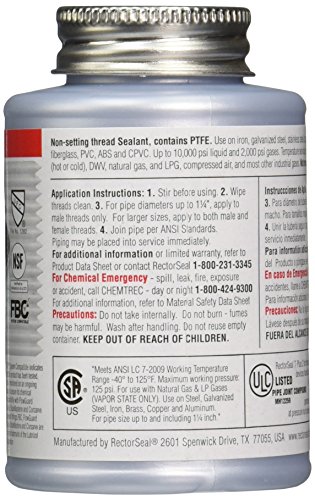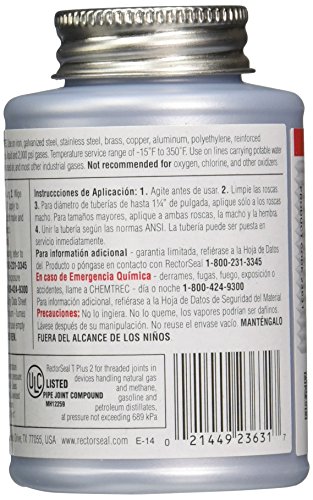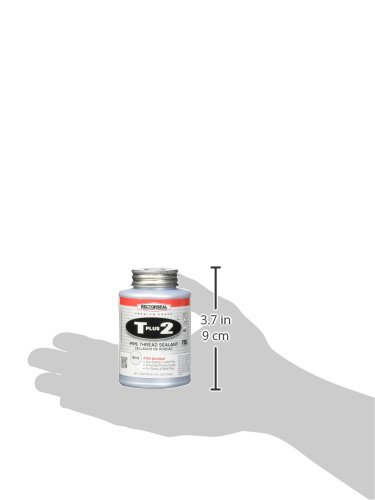- Contains Teflon, and synthetic fibers for a stronger seal
- For use on natural gas, lp gas, refrigerants, water, fuels, oils, etc.
- Made in United states
- Non-hardening thread sealant containing PTFE plus synthetic fibers
- These fibers dispersed in a resinous base combined with inert mineral fillers provide maximum sealing performance
- Its low coefficient of friction allows tighter joint makeup with lower torque
- It also breaks out easily without galling, seizing, or damaging threads
- It is excellent for service where immediate pressurization is necessary
- Non-hardening thread sealant containing PTFE plus synthetic fibers
- These fibers dispersed in a resinous base combined with inert mineral fillers provide maximum sealing performance
- Its low coefficient of friction allows tighter joint makeup with lower torque
- It also breaks out easily without galling, seizing, or damaging threads
- It is excellent for service where immediate pressurization is necessary
-
Information
-
Twitter
-
Pinterest
-
Youtube
-
Facebook





Siyathemba Mangwana
Great Stuff
I use this thread sealant AND teflon tape. A plumber taught me that trick and it has served me well. In cases where once you tighten the threaded pipe, you cannot afford to have any leakage, the combination is fail-safe.
Irene Maciulis
It works!
This stuff is for serious. I had a brass threaded joint that kept leaking, even with ten wraps of Teflon tape, then twenty, and finally with rectorseal #5. Five wraps of Teflon tape plus this stuff did the trick. No more leaking! The brush is way easier to use than a tube, too.
Rhonda Brown
Easy to use and works!
My well pump had to be replaced after 8 years of heavy use. PVC piping fittings resealed to the pump included 3/4 close nipple (schedule 80) into female cast iron, 3/4 PVC female to the close nipple, metal priming plug into female 3/4 cast iron on the pump, and 1.5 inch PVC male fitting into cast iron female water inlet on the pump. Used high quality name brand pipe thread sealer on first attempt; every joint had slow leaks. Ordered Rectorseal 23631 and let plump leak for 3 days to see if any fittings would quit leaking; none did. Cleaned all fittings, applied Rectorseal, and NONE leaked when pressure was applied. Ran lawn sprinkler for 3 hours and no joints have leaked at all. Look no further if you do not want to do it over.
Debbra Burns
It doesn't look like it would work, but it does
If you've ever put together a significant amount of plumbing, you know the all-too familiar feeling of dread when you turn on the water and find a leak. On this particular install, I was putting in a water softener, whole house water filter, and pressure gauge using a combination of ProPEX and brass fittings with NPT threads. I initially used teflon tape to seal the NPT fittings. After a good 6 hours of work, I turned the water on and found that the ProPEX fittings sealed perfectly, but my heart sunk after finding that almost every single NPT fitting was dripping. Even after draining the lines, disassembly, fresh teflon tape, and gargantuan torque on each fitting, I turned the water on again and found that they still leaked. Enter Rectorseal. Just by looking at the Rectorseal, I had pretty low expectations. It's a highly viscous creamy substance with little strands of something in the mix. The brush they give you is about as messy as Jimmy Hendrix's hair and is pretty terrible to try to use. I went on blind faith and slapped it on some clean threads, tightened everything up, grabbed some towels, turned on the water and...it worked! I didn't even torque the fittings down to the level they were at with the teflon tape. They were just "snug" and it sealed perfectly. I won't touch teflon tape again and will instead be putting this stuff on my pipes from now on.
Aida Cunanan
A miracle product
I recently purchased a new dishwasher and installing it has been an absolute nightmare. The brass elbow piece that connected the water line to the plastic intake on the bottom of the dishwasher would not form a proper seal and developed a leak sometime after I installed it- resulting in a slow drip that ruined the flooring in my kitchen (totally my fault for not checking it again a few days after I did the install). I tried several things to get that seal right, including ordering a new elbow piece and using plumbers tape but I just could not get it to stop dripping. I bought this stuff as a last resort and I am so thankful that I did because I have not seen one drop of water under that dishwasher since I used this product. It completely fixed the seal between the brass elbow and the plastic connector. I just gooped this stuff all around the plastic piece and then screwed the brass elbow back into place, making sure it had a tight but not too tight connection and voila! I've been leak free for two weeks and 3 full dishwasher cycles now. I really could not recommend this stuff more and will likely use it on all new water connections going forward to prevent the same disaster that I caused in my kitchen the first go-round.
Christine Jay Taaca Damasco
Even seals black holes!
So I did some experimentation...and this stuff is a winner in conjunction with Teflon tape. Teflon tape alone worked for some applications. On a stubborn compressed air fitting, it wouldn't create a good seal. I first tried T+2 alone, but there was still some leakage-multiple tries. Both combined, though... bingo! I use the combination everywhere now. Did some compressed air fittings and a car's cooling system. No leaks whatsoever. It's a little weird to use, but it's very easy. Just keep it off the stuff you don't want stained!
Tiffany Alipater
Worked where others failed
Worked on a dripping PVC threaded joint, where the big box store tape and sealant had both failed. Application is for a connection in a sump pump system, where it must withstand medium pressure from the water column and pumping. This sealant is clearly thicker than the other stuff, yet the threads went together well. Will definitely use this brand from now on.
Monalisa Basu
Really works
Have to agree with everyone else. I thought it might have gone bad, little lumpy. Put this on a copper pipe connection and no leak. The Teflon tape I used first was leaking. Success!
Robert Victor Moore
A must have sealant for all pool owners.
I have tried almost everything to stop the nuisance drips associated with pool pump area plumbing. I can speak from experience that no matter what I tried it came down to "tight was not good enough (it still leaked), whereas over tightening caused cracks and replacement of a few multi-port valves." Then I discovered Rectorseal T plus 2. This stuff is GREAT!!! For small diameter fittings (under 1 1/2") you can do the male threads only. But for the 1 1/2" size you are best off doing both the male and female ends. Once this is applies you only need to screw things together "hand tight." This will make for an leak-free connection and will not crack any plastic fittings.
Jazmine Solis
Messy, but does the job very well
Think of this like liquid PFTE (plumber's) tape, or teflon tape. It seals the gaps between threads on fittings that connect hose and pipe carrying compressed gas. The cap has a brush on the inside. Brush a coat all the way around the threads, spread it evenly, and screw in the fitting and it's ready to go. The product itself is messy. It has the consistency of lithium grease mixed with sand. Wear some disposable gloves when you apply it. Unlike PFTE and teflon tape, this stuff fills the gaps between threads very evenly, giving you a superior seal. It is non-hardening, so it won't bind the threads - quite the opposite, it acts like a lubricant making the fitting easier to unscrew when you want to take it apart. You'll want to make sure you spread it evenly all the way around the threads. If you miss a section, you'll have a leaky fitting, and if it's very thin in one spot, it can let air bubble out through the product. If you don't mind the mess and want the best possible seal, this is a great choice.